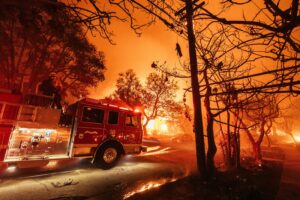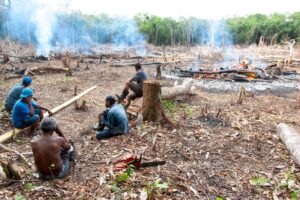Welcome to Carbon Brief’s Cropped.
We handpick and explain the most important stories at the intersection of climate, land, food and nature over the past fortnight.
This is an online version of Carbon Brief’s fortnightly Cropped email newsletter. Subscribe for free here.
Key developments
Latin America news roundup
TREE FELLING FALLS: Political shifts in Brazil and Colombia have “had a significant impact on tree felling”, with large reductions in deforestation occurring in both countries over 2023, according to analysis from the University of Maryland and the World Resources Institute that was covered by BBC News. Tree loss in the Brazilian Amazon decreased by 39%, although in the Cerrado – an important savannah in Brazil – it increased by 6%. In Colombia, primary forest loss decreased by nearly 50%, compared to last year. But, the outlet added, “increased tree felling and fires in Bolivia, Laos and Nicaragua wiped out many of these gains”.
WHERE THERE’S SMOKE: According to satellite data released last week, Venezuela “is battling a record number of wildfires”, fuelled in part by intense drought in the region, Reuters reported. More than 30,000 “fire points” were recorded in the country during the first three months of the year. The newswire wrote: “Man-made fires that are often set to clear land for agriculture are spreading out of control thanks to high temperatures and low rainfall in northern South America, as well as a lack of prevention planning, researchers say.” A University of Oxford fire researcher said that the fires “could be a worrying sign for what’s ahead” when Brazil enters its dry season.
COMMISSION CHANGE: The scientific community must “speak out strongly” against proposed changes to Mexico’s National Commission for the Knowledge and Use of Biodiversity (CONABIO), two academics wrote in an editorial in the journal Science. They explained that the government intends to “reduce CONABIO from a multi-ministry federal government agency to a branch within the environment ministry” and argued that this change would “strip CONABIO of its independent voice, credibility and influence on national and international policy”. The government is expected to make a final decision by the end of this month.
DENGUE ‘SURGE’: The Pan American Health Organization (PAHO) warned of a “surge in dengue cases in the Americas”, with more than 3.5m cases recorded to date – “three times more cases than those reported for the same period in 2023”, which was itself a record year, PAHO director Jarbas Barbosa said. According to PAHO: “Several environmental and social factors contribute to the spread of dengue, including rising temperatures, extreme weather events and the El Niño phenomenon.” Urbanisation and population growth also play a role, the organisation added.
Africa drought ‘disaster’
NATIONAL EMERGENCIES: More than 24 million people in southern Africa face hunger, malnutrition and water scarcity due to the combined impact of drought and floods, according to a warning from the charity Oxfam, CNN reported. It comes after Zimbabwe joined Zambia and Malawi in declaring a state of disaster over the drought, according to Sky News. Zimbabwe president Emmerson Mnangagwa made the emergency declaration in a speech on 3 April, where he called for $2bn (£1.6bn) in humanitarian aid, the broadcaster said. The Associated Press (AP) spoke to a mother affected by the drought in Zimbabwe.
CLIMATE ROLE: The “erratic” weather in southern Africa, which has lurched between drought and floods in recent months, is likely “spurred” by human-caused climate change, which is making extreme events more unpredictable, the AP said. It added that conditions have been worsened by El Niño, the naturally occurring climate phenomenon that periodically affects much of the globe. In southern Africa, El Niño “means below-average rainfall” and “sometimes drought”, the newswire reported.
EXTREME CONTINENT: Many other parts of the continent continued to face severe – and, in many cases, record-breaking – extreme weather. Much of northern Africa continued to face extreme heat, with the Moroccan city of Oujda recording a “minimum temperature” for April that was 7C higher than the previous record, according to a Twitter account tracking extreme temperatures. That temperature was close to the all-time record, logged in the month of July. (“Minimum temperature” refers to the coolest temperature in a 24-hour period, with high minimum temperatures indicating dangerously hot nights.) West Africa also continued to face record heat. Carbon Brief reported on how Africa’s most populous nation, Nigeria, was coping with the extreme temperatures.
Spotlight
The ‘grave threat’ of ghost roads
In this spotlight, Carbon Brief reports on a new study detailing the impact of “ghost roads” on deforestation rates in the Asia Pacific region.
“Ghost roads” – illegal or informal roads that do not appear on any map – are fast expanding in biodiversity-rich tropical nations.
Carved out by farmers, miners, loggers, land grabbers and drug traffickers, these illicit roads give more direct access to pristine tropical forests – and help extractors carry out their activities while evading detection by authorities or NGOs.
The absence of ghost roads from official records or international datasets makes understanding the scale of their impact on tropical forests extremely difficult.
A new study published in Nature this week aimed to reverse this.
“I think we all knew that ghost roads were a serious problem, but they hadn’t been studied in a concerted way,” study author Prof Bill Laurance, a conservation biologist at James Cook University in Cairns, Australia, told Carbon Brief.
Volunteer army
The research team focused on three tropical islands in the Asia Pacific: Borneo, Sumatra and New Guinea.
To try to understand the extent of ghost roads on the islands, the researchers deployed an army of more than 200 trained volunteers.
These volunteers walked over 1.42m plots, each one square kilometre in area, noting down the existence of roads that were missing from leading global datasets.
Study lead author Jayden Engert, a conservation ecologist and PhD student at James Cook University, told Carbon Brief that a broad range of people volunteered to help out with the mapping effort:
“We found volunteers through many different avenues, chiefly by advertising within our university and at other universities. We also ran a volunteer Map-athon with the Facebook group ‘Wild Green Memes for Ecological Fiends’, which brought in a decent amount of volunteers and also helped to raise awareness of the issue.”
Ghosts detected
The mapping effort revealed 1.37m km of ghost roads – 3-6.6 times more roads than were present in leading road datasets.
“I was blown away by how many unmapped roads there were,” Engert told Carbon Brief.
To understand how the ghost roads could be affecting deforestation rates, the scientists developed a map of their study area and quantified the percentage of forest loss in each plot.
They then used modelling to determine how the forest loss correlated with 38 biological and socioeconomic factors related to tree cover, including population density, distance to the nearest city and protected-land status – as well as ghost-road density and distance from ghost roads.
The research found that ghost-road density had by far the strongest link with forest loss out of all of the 38 factors studied.
Furthermore, ghost-road building “almost always preceded local forest loss”, the researchers wrote in their study.
They also found that the relationship between road density and forest was nonlinear, “with deforestation peaking soon after roads penetrate a landscape and then declining as roads multiply and remaining accessible forests largely disappear”.
They concluded by saying:
“Collectively, our findings suggest that burgeoning, poorly studied ghost roads are among the gravest of all direct threats to tropical forests.”
Laurance told Carbon Brief that their findings are likely to apply to other parts of the tropics:
“There’s absolutely no doubt in my mind that other developing tropical nations are facing similar challenges with ghost roads. We also have been working in the Amazon and central Africa for the past several decades, and there we see many similar and equally daunting realities on the ground.”
News and views
FARM FLU: The US Department of Agriculture has confirmed cases of the “highly pathogenic” avian influenza in dairy cows in Idaho, bringing the number of confirmed outbreaks to 12 herds across five states, with other tests ongoing in presumptive positive cases. The country’s largest fresh egg producer also reported an outbreak, leading to “rising concern” despite assurances that the “risk to the public remains low”, the Associated Press reported. The detection of the virus in cattle raises “critical questions about whether the country is equipped to handle an influenza outbreak after the coronavirus pandemic…exposed the weaknesses in the nation’s public health infrastructure and decimated the public’s trust in key federal agencies”, the Washington Post reported.
INDIGENOUS INDONESIANS: Indonesian president-elect Prabowo Subianto must prioritise ratifying the country’s Indigenous Peoples bill, two Indigenous-rights activists argued in China Dialogue. The bill was first proposed in 2009, but president Joko Widodo failed to ratify it despite “repeated promises to do so”, the writers noted, adding: “Prabowo’s new government appears set to continue expanding Indonesia’s domestic resource-processing capabilities…signal[ling] the continued, unjust plunder of Indigenous territory.” Indonesia is home to around 22 million Indigenous people and more than 2,500 Indigenous communities. They face “deforestation, agricultural crises, marginalisation and discrimination and the usurpation of customary rights”, as well as voter disenfranchisement, the activists said.
NEW BIODIVERSITY CHIEF: BusinessGreen reported that German diplomat and environmental-policy expert Astrid Schomaker has been appointed the next executive secretary of the Convention on Biological Diversity (CBD), the UN body that oversees negotiations on biodiversity loss. According to the publication, Schomaker has spent the last seven years overseeing environmental diplomacy and global sustainable development at the European Commission. She replaces the acting executive secretary, British CBD veteran Dr David Cooper. Carbon Brief published an in-depth interview with the last permanent executive secretary, Tanzanian lawyer and diplomat Elizabeth Maruma Mrema, in 2022.
WHALE OF A TIME: Māori king Tuheitia Pōtatau Te Wherowhero VII and other Indigenous leaders in the Pacific have “urged the legal recognition of whales as persons with inherent rights”, according to the Pacific Islands News Association. The leaders are endorsing the He Whakaputanga Moana, or the Declaration for the Ocean, which “outlines a comprehensive plan” for protecting whales from “unsustainable practices, pollution and climate change”, the outlet explained. It will do so through establishing protected areas and integrating Indigenous knowledge with other science. Travel Tou Ariki, a high chief from the Cook Islands, said: “Whales play a vital role in the health of our entire ocean ecosystem…We must act with urgency to protect these magnificent creatures before it’s too late.”
BIG MEAT COP: Lobbyists from the world’s largest meat companies have celebrated a “positive outcome” from the last global climate summit, COP28, according to a DeSmog investigation. Speaking on a virtual panel organised by the trade outlet FeedStuffs, three representatives for US livestock firms said they were left “excited” and “enthusiastic” for their industry’s prospects after the summit, which saw countries commit to a series of voluntary pledges for tackling agricultural emissions without addressing meat consumption. Constance Cullman, the president of the US lobby group the Animal Feed Industry Association (AFIA) said COP28 left her organisation with “a far more positive outcome than we had anticipated”, according to DeSmog.
STANDING TOGETHER: Advocacy groups in Brazil, the Democratic Republic of the Congo, Guatemala, Kenya, Liberia and Mexico have launched a new initiative to protect environmental defenders, Liberia’s Daily Observer reported. The initiative will provide “partnerships, financial support and training” for civil-society organisations to protect them against the risks that environmental defenders face, such as threats, violence and smear campaigns, the newspaper said. Three environmental defenders were recently killed during protests in Kinjor, Liberia.
Watch, read, listen
WASTED WETLANDS: An investigation by Ireland’s Noteworthy found that the planting of non-native trees on peatlands could put some of the country’s “cleanest” rivers and streams at risk.
SALINE INHABITANTS: Hakai Magazine wrote about how Utah’s shrinking Great Salt Lake is imperilling the strange creatures found in its waters.
TREE SMUGGLING: A four-part investigation by the Africa Report, in collaboration with the Pulitzer Center’s Rainforest Investigations Network, examined timber trafficking from the Democratic Republic of the Congo.
ROCKY MOUNTAIN HIGH: A feature in High Country News explored how drones can be used in service of conservation of predators in the Rocky Mountains.
New science
Threat of mining to African great apes
Science Advances
Up to one-third of Africa’s great apes face risks from mining projects, new research found. The study looked at the overlap between industrial mining projects and great ape distribution in 15 African countries, excluding the Democratic Republic of the Congo due to a lack of available data. The research found that industrial mining projects overlap with the habitat of nearly 180,000 apes. It also found that the overlap was largest in west African nations, including Senegal and Sierra Leone. In the paper, the authors noted that the “rapid growth of clean energy technologies is driving a rising demand for critical minerals”, which are increasingly being mined in Africa.
The asymmetric impacts of international agricultural trade on water use scarcity, inequality and inequity
Nature Water
A new study found that the water “embedded” in agricultural trading “disproportionately benefits the rich and widens both the water scarcity and inequity gap between the poor and the rich”. Researchers used a global model of crop water requirements to simulate the amount of water used for irrigation for 26 different crops, then analysed how international trade affects water scarcity and inequity in eight countries. They found that the poorest people in developing countries “suffer[ed] from both increased water scarcity and inequity”, but poor populations in developed countries were more likely to benefit. They also identified the trade of staple crops as “the major driving factor” affecting these in most countries, due to the large volumes of staple crops traded.
Significant shifts in latitudinal optima of North American birds
Proceedings of the National Academy of Sciences
The optimal location for North American birds has shifted northward by an average rate of 1.5km each year in response to climate change, a new study found, representing a total distance moved of 82.5km over the past 55 years. The research uses modelling to estimate the “latitudinal optima” of 209 American bird species, drawing on bird population abundance data over the past half-century. It found that one-third of the species studied showed a “significant shift of their optimum” over the study period, with birds in western North America experiencing the biggest shifts. The results “directly implicate climate-induced increases in temperature as the primary driver” of bird abundance shifts, the researchers said.
In the diary
- 10-12 April: 2024 Ocean Decade conference | Barcelona
- 16-19 April: Scoping meeting for the Intergovernmental Panel on Climate Change (IPCC) special report on cities | Riga
- 19 April: Start of India’s general election
- 23-29 April: Fourth session of the Intergovernmental Negotiating Committee to develop an international legally binding instrument on plastic pollution, including in the marine environment | Ottawa
Cropped is researched and written by Dr Giuliana Viglione, Aruna Chandrasekhar, Daisy Dunne, Orla Dwyer and Yanine Quiroz. Please send tips and feedback to cropped@carbonbrief.org
The post Cropped 10 April 2024: ‘Ghost roads’ deforestation; Record wildfires; Southern Africa drought appeared first on Carbon Brief.
Cropped 10 April 2024: ‘Ghost roads’ deforestation; Record wildfires; Southern Africa drought
Climate Change
UN report: Five charts showing how global deforestation is declining
The amount of forest lost around the world has reduced by millions of hectares each year in recent decades, but countries are still off track to meet “important” deforestation targets.
These are the findings of the Global Forest Resources Assessment – a major new report from the UN’s Food and Agriculture Organization – which says that an estimated 10.9m hectares (Mha) of land was deforested each year between 2015 and 2025.
This is almost 7Mha less than the amount of annual forest loss over 1990-2000.
Since 1990, the area of forest destroyed each year has halved in South America, although it still remains the region with the highest amount of deforestation.
Europe was the only region in the world where annual forest loss has increased since 1990.
Agriculture has historically been the leading cause of deforestation around the world, but the report notes that wildfires, climate change-fuelled extreme weather, insects and diseases increasingly pose a threat.
The Global Forest Resources Assessment is published every five years. The 2025 report compiles and analyses national forest data from almost every country in the world over 1990-2025.
Carbon Brief has picked out five key findings from the report around deforestation, carbon storage and the amount of forest held within protected areas around the world.
1. Rates of deforestation are declining around the world
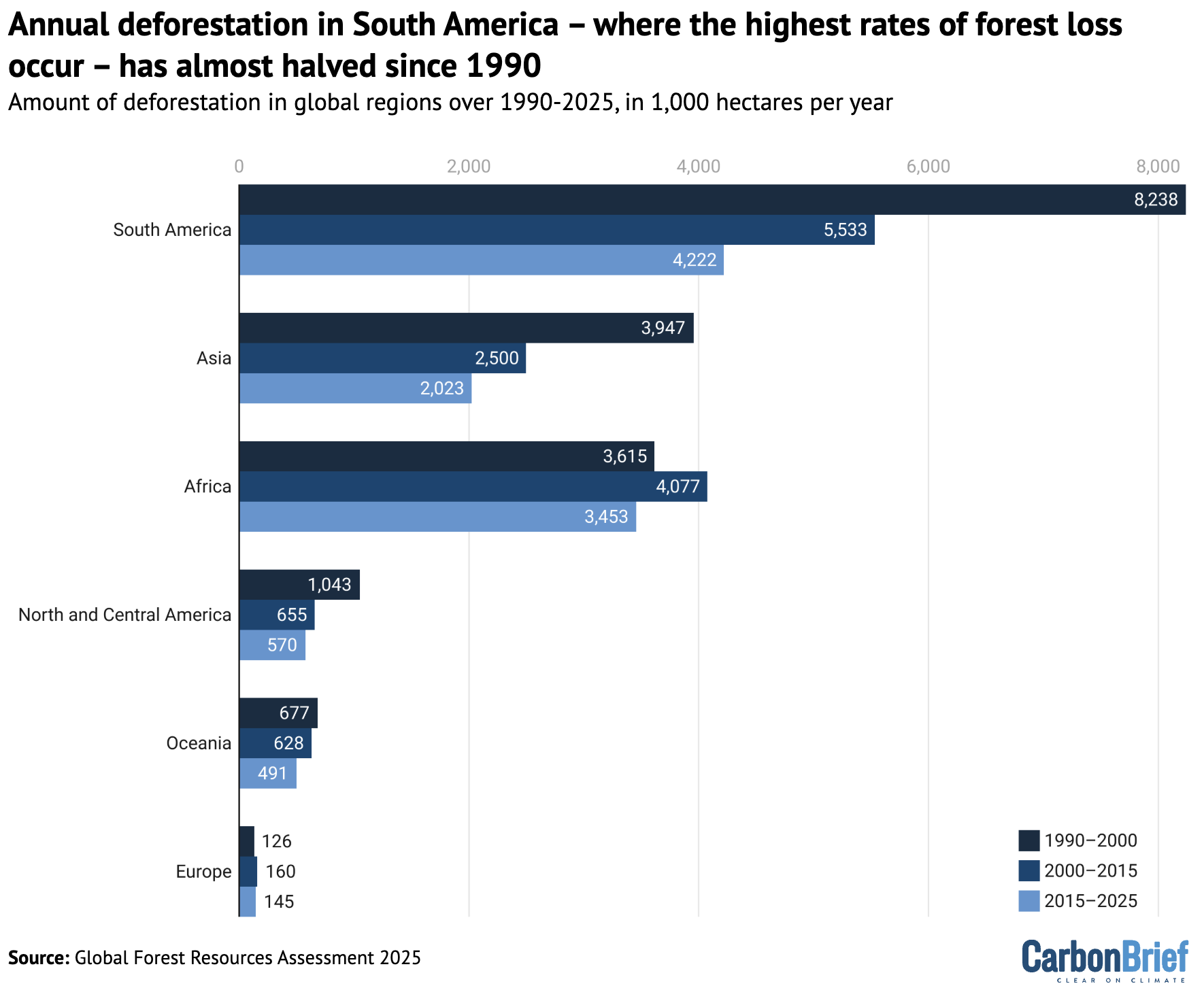
Rates of annual deforestation, in thousands of hectares, in South America, Asia, Africa, North and Central America, Oceania and Europe over 1990-2000 (dark blue), 2000-15 (medium blue) and 2015-25 (light blue). Source: Global Forest Resources Assessment 2025
In total, around 489Mha of forest have been lost due to deforestation since 1990, the new report finds. Most of this – 88% – occurred in the tropics.
This breaks down to around 10.9Mha of forest lost each year between 2015 and 2025, a reduction compared to 13.6Mha of loss over 2000-15 and 17.6Mha over 1990-2000.
Deforestation refers to the clearing of a forest, typically to repurpose the land for agriculture or use the trees for wood.
The chart above shows that South America experiences the most forest loss each year, although annual deforestation levels have halved from 8.2Mha over 1990-2000 to 4.2Mha over 2015-25.
Annual deforestation in Asia also saw a sizable reduction, from 3.9Mha over 1990-2000 to 2Mha over 2015-25, the report says.
Europe had the lowest overall deforestation rates, but was also the only region to record an increase over the last 35 years, with deforestation rates growing from 126,000 hectares over 1990-2000 to 145,000 hectares in the past 10 years.
Despite the downward global trend, FAO chief Dr Qu Dongyu notes in the report’s foreword that the “world is not on track to meet important global forest targets”.
In 2021, more than 100 countries pledged to halt and reverse global deforestation by 2030. But deforestation rates in 2024 were 63% higher than the trajectory needed to meet this 2030 target, according to a recent report from civil society groups.
The goals of this pledge were formally recognised in a key text at the COP28 climate summit in Dubai in 2023, which “emphasise[d]” that halting and reversing deforestation and forest degradation by 2030 would be key to meeting climate goals.
2. Global net forest loss has more than halved since 1990
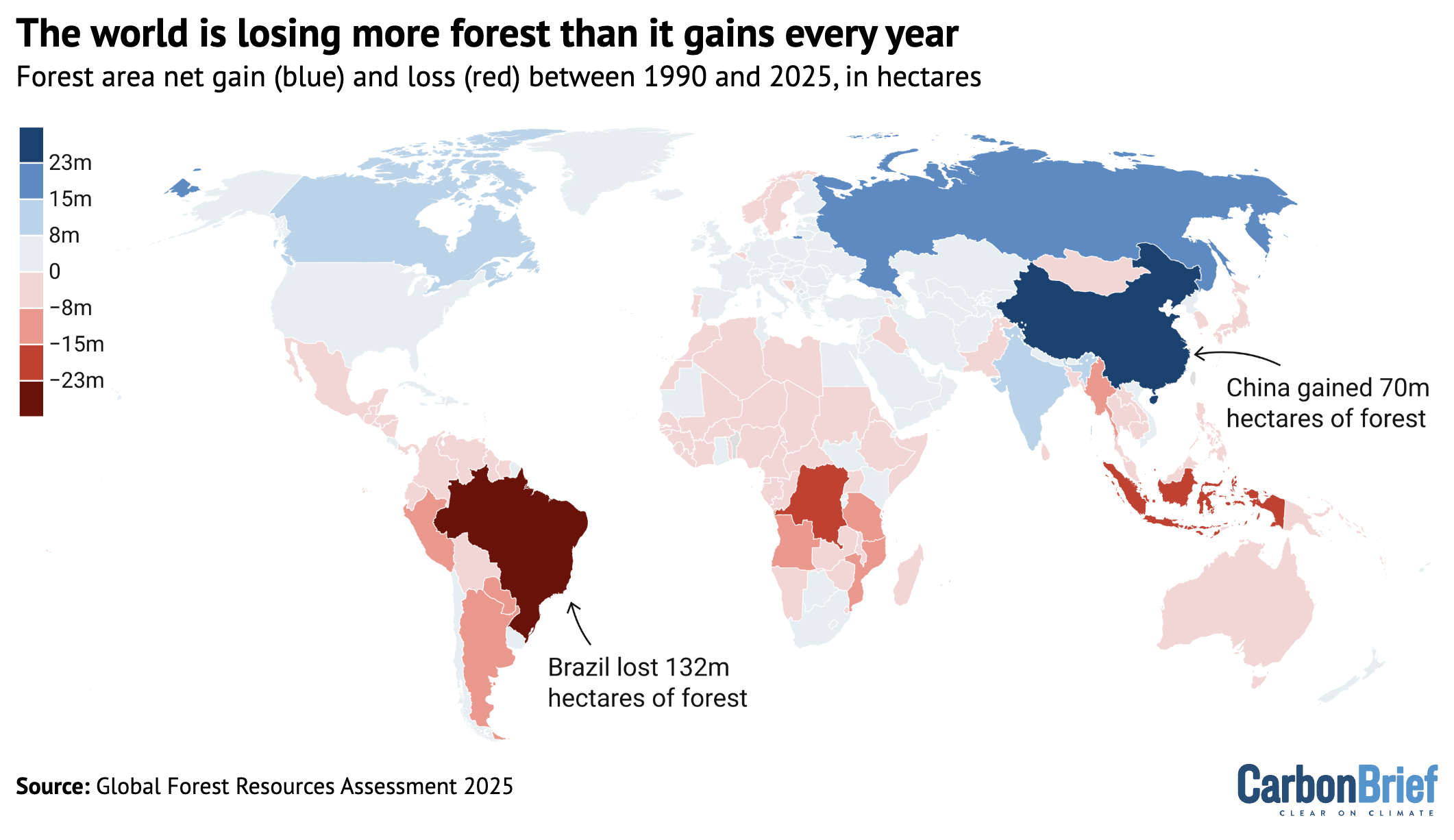
Forest area net change by country between 1990 and 2025, in hectares. Source: Global Forest Resources Assessment 2025
The new report finds that forests cover more than 4bn hectares of land, an area encompassing one-third of the planet’s land surface.
More than half of the world’s forested area is located in just five countries: Russia, Brazil, Canada, the US and China.
The map above shows that, overall, more forest is lost than gained each year around the world. There was 6.8Mha of forest growth over 2015-25, but 10.9Mha of forest lost.
The annual rate of this global net forest loss – the amount that deforestation has exceeded the amount regrown – has more than halved since 1990, dropping from 10.7Mha over 1990-2000 to 4.1Mha over 2015-25.
The report says this change was due to reduced deforestation in some countries and increased forest expansion in others. However, the rate of forest expansion has also slowed over time – from 9.9Mha per year in 2000-15 to 6.8Mha per year in 2015-25.
There are many driving factors behind continuing deforestation. Agriculture has historically been the leading cause of forest loss, but wildfire is increasingly posing a threat. Wildfires were the leading driver of tropical forest loss in 2024 for the first time on record, a Global Forest Watch report found earlier this year.
The new UN report says that an average of 261Mha of land was burned by fire each year over 2007-19. Around half of this area was forest. Around 80% of the forested land impacted by fires in 2019 was in the subtropics – areas located just outside tropical regions, such as parts of Argentina, the US and Australia.
The report notes that fire is widely used in land management practices, but uncontrolled fires can have “major negative impacts on people, ecosystems and climate”.
It adds that researchers gathered information on fires up as far as 2023, but chose to focus on 2007-19 due to a lack of more recent data for some countries.
A different report from an international team of scientists recently found that fires burned at least 370Mha of land – an area larger than India – between March 2024 and February 2025.
3. Many countries are hugely increasing their forest area
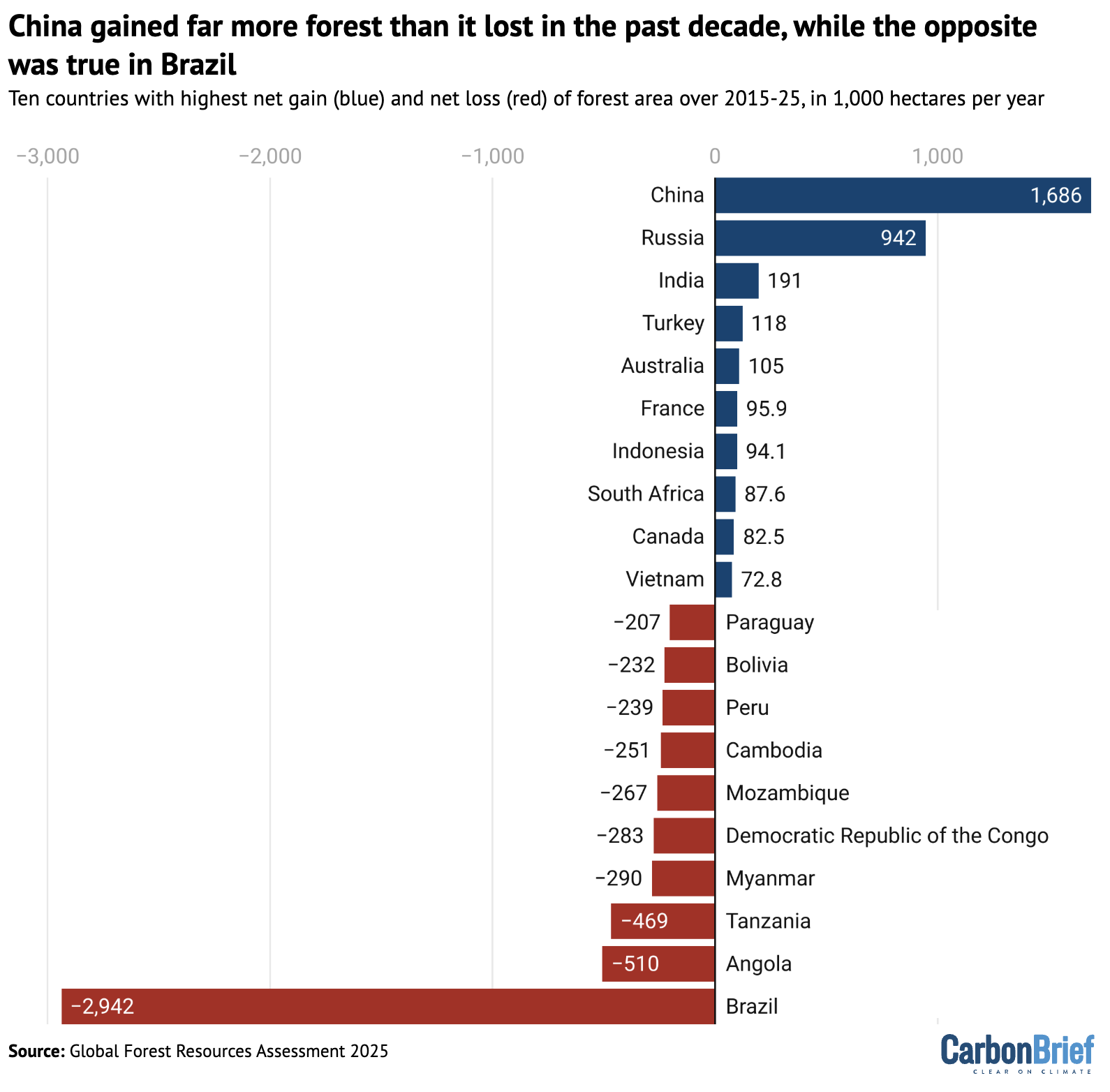
Top 10 countries for annual net gain (blue) and net loss (red) of forest area over 2015-25, in 1,000 hectares per year. Source: Global Forest Resources Assessment 2025
Globally, deforestation is declining, but the trend varies from country to country.
The chart above shows that some nations, such as China and Russia, added a lot more forest cover than they removed in the past decade through, for example, afforestation programmes.
But in other countries – particularly Brazil – the level of deforestation far surpasses the amount of forest re-grown.
Deforestation in Brazil dropped by almost one-third between 2023 and 2024, news outlet Brasil de Fato reported earlier this year, which was during the time Luiz Inácio Lula da Silva took over as president. The new UN report finds that, on average, Brazil lost 2.9Mha of forest area each year over 2015-25, compared to 5.8Mha over 1990-2000.
Russia’s net gain of forest cover increased significantly since 1990 – growing from 80,400ha per year in 1990-2000 to 942,000ha per year in 2015-25.
In China, although it is also planting significant levels of forest, the forest level gained has dropped over time, from 2.2Mha per year in 2000-15 to 1.7Mha per year in 2015-25.
Levels of net forest gain in Canada also fell from 513,000ha per year in 2000-15 to 82,500ha per year in 2015-25.
In the US, the net forest growth trend reversed over the past decade – from 437,000ha per year of gain in 2000-15 to a net forest loss of 120,000ha per year from 2015 to 2025.
Oceania reversed a previously negative trend to gain 140,000ha of forests per year in the past decade, the report says. This was mainly due to changes in Australia, where previous losses of tens of thousands of hectares each year turned into an annual net gain of 105,000ha each year by 2015-25.
4. The world’s forests hold more than 700bn tonnes of carbon
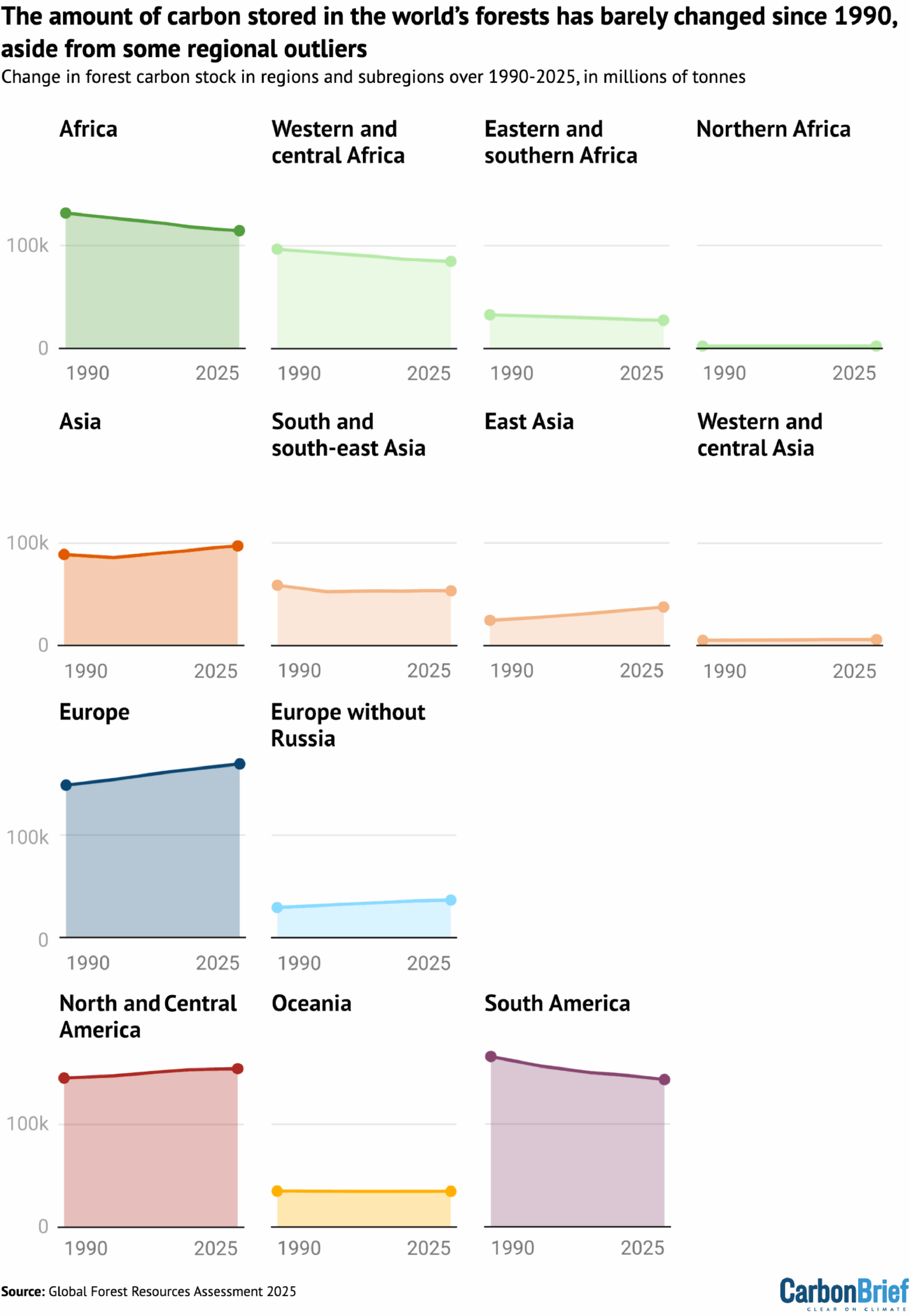
Changes in forest carbon stock by region and subregion of the world over 1990-2025. Source: Global Forest Resources Assessment 2025
The “carbon stock” of a forest refers to how much carbon is stored in its trees and soils. Forests are among the planet’s major carbon sinks.
The new report estimates that forests stored an estimated 714bn tonnes, or gigatonnes, of carbon (GtC) in 2025.
Europe (including Russia) and the Americas account for two-thirds of the world’s total forest carbon storage.
The global forest carbon stock decreased from 716GtC to 706GtC between 1990 and 2000, before growing slightly again by 2025. The report mainly attributes this recent increase to forest growth in Asia and Europe.
The report notes that the total amount of carbon stored in forests has remained largely static over the past 35 years, but with some regional differences, as highlighted in the chart above.
The amount of carbon stored in forests across east Asia, Europe and North America is “significantly higher” now due to expanded forest areas, but it is lower in South America, Africa and Central America.
Several studies have shown that there are limitations on the ability of forests to keep absorbing CO2, with difficulties posed by hotter, drier weather fuelled by climate change.
A 2024 study found that record heat in 2023 negatively impacted the ability of land and ocean sinks to absorb carbon – and that the global land sink was at its weakest since 2003.
Another study, published in 2022, said that drying and warming as a result of deforestation reduces the carbon storage ability of tropical forests, especially in the Congo basin and the Amazon rainforest.
5. Around one-fifth of the world’s forests are located in protected areas
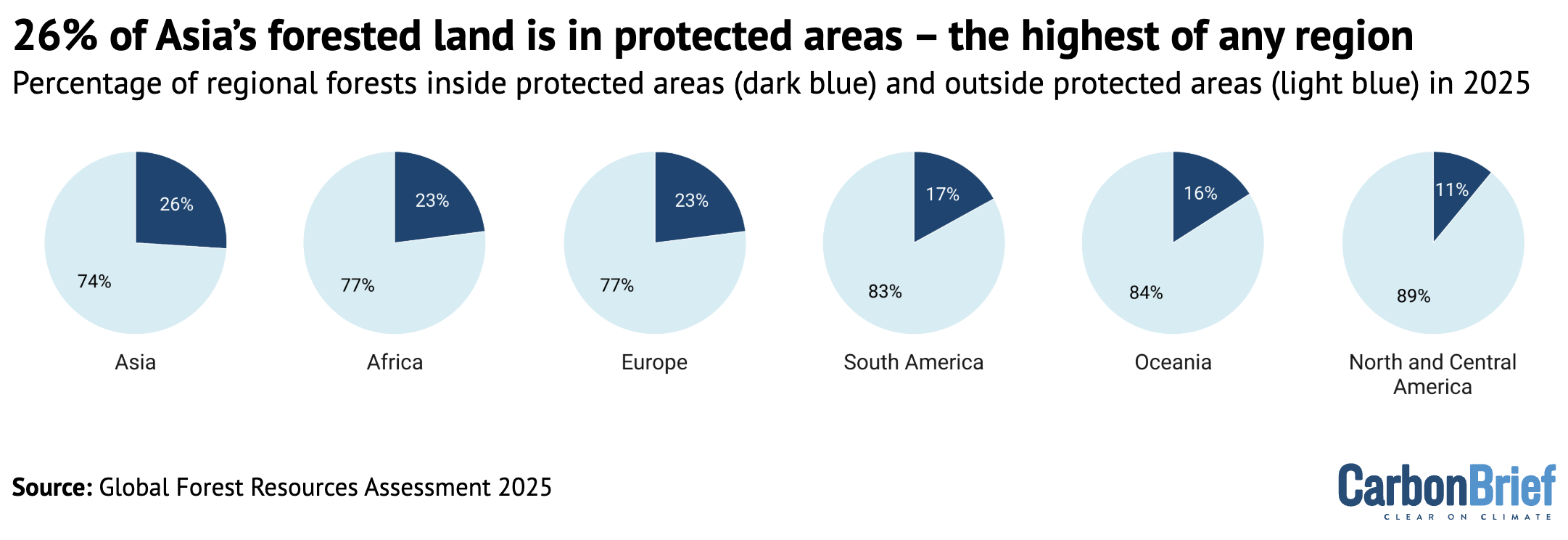
The percentage of forest land in Asia, Africa, Europe, South America, Oceania and North and Central America contained inside protected areas (dark blue) and outside protected areas (light blue) in 2025. Source: Global Forest Resources Assessment 2025
The amount of forested land located in protected areas increased across all regions between 1990 and 2025.
For an area to be considered “protected”, it must be managed in a way that conserves nature.
Around 20% of the world’s forests are located in these protected areas, the new report finds, which amounts to 813Mha of land – an area almost the size of Brazil.
Nearly every country in the world has pledged to protect 30% of the Earth’s land and sea by 2030. However, more than half of countries have not committed to this target on a national basis, Carbon Brief analysis showed earlier this year.
Almost 18% of land and around 8% of the ocean are currently in protected areas, a UN report found last year. The level is increasing, the report said, but considerable progress is still needed to reach the 2030 goal.
The new UN report notes that Europe, including Russia, holds 235Mha of protected forest area, which is the largest of any region and accounts for 23% of the continent’s total forested land.
As highlighted in the chart above, 26% of all forests in Asia are protected, which is the highest of any region. The report notes that this is largely due to a vast amount of protected forested land in Indonesia.
Three countries and one island territory reported that upwards of 90% of their forests are protected – Norfolk Island, Saudi Arabia, Cook Islands and Uzbekistan.
The post UN report: Five charts showing how global deforestation is declining appeared first on Carbon Brief.
UN report: Five charts showing how global deforestation is declining
Climate Change
Federal Appeals Court Pauses Litigation Over Florida’s Alligator Alcatraz
The Trump administration had sought the stay of proceedings in the case, arguing its attorneys were furloughed during the government shutdown. The plaintiffs say the administration is picking and choosing which cases to litigate.
A federal appeals court paused litigation Wednesday brought by environmental groups over Florida’s Alligator Alcatraz, the hastily assembled Everglades detention site where the Trump administration aims to incarcerate and deport thousands of undocumented migrants.
Federal Appeals Court Pauses Litigation Over Florida’s Alligator Alcatraz
Climate Change
Breach of Contract or Constitutional Crisis?
An appellate court will determine how to handle the Trump administration’s cancellation of hundreds of climate and environmental justice grants.
The U.S. Fourth Circuit Court of Appeals in Richmond, Virginia, heard arguments Thursday on whether the Trump administration’s cancellation of billions of dollars in environmental and climate grants earlier this year violated the Constitution or was merely a contract dispute.
-
Climate Change2 years ago
Spanish-language misinformation on renewable energy spreads online, report shows
-
Climate Change2 months ago
Guest post: Why China is still building new coal – and when it might stop
-
Climate Change Videos2 years ago
The toxic gas flares fuelling Nigeria’s climate change – BBC News
-

 Greenhouse Gases1 year ago
Greenhouse Gases1 year ago嘉宾来稿:满足中国增长的用电需求 光伏加储能“比新建煤电更实惠”
-
Greenhouse Gases2 months ago
Guest post: Why China is still building new coal – and when it might stop
-

 Climate Change1 year ago
Climate Change1 year ago嘉宾来稿:满足中国增长的用电需求 光伏加储能“比新建煤电更实惠”
-

 Carbon Footprint2 years ago
Carbon Footprint2 years agoUS SEC’s Climate Disclosure Rules Spur Renewed Interest in Carbon Credits
-
Renewable Energy3 months ago
US Grid Strain, Possible Allete Sale


